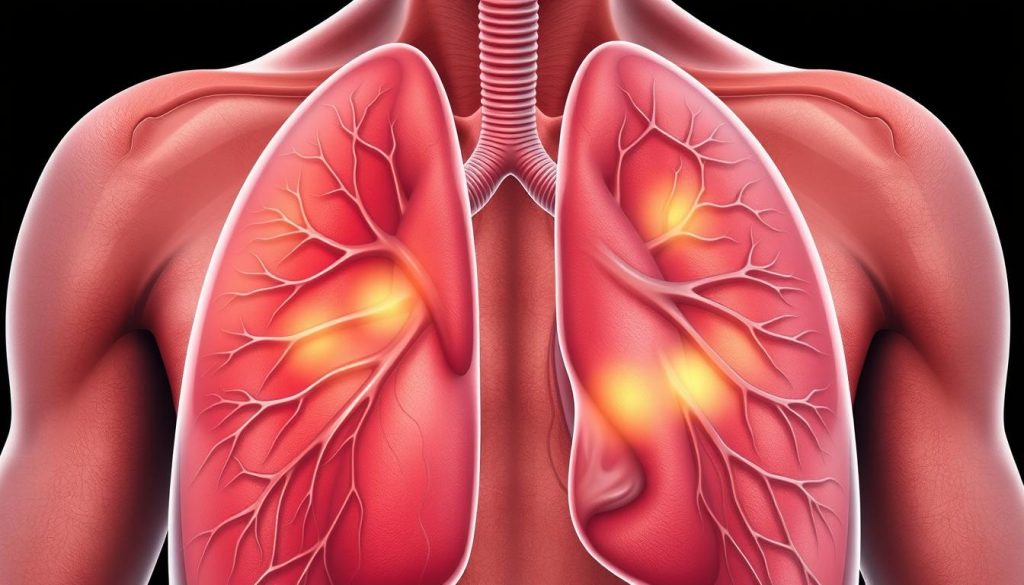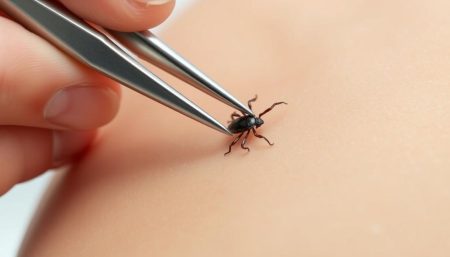The subtle sounds of our breathing can tell us a lot about our health. The pleural rub sound is one such sign. It comes from the chest and hints at pleural disorders. Doctors listen for these sounds to find the cause of chest friction signs.
Understanding these sounds is key to diagnosing and treating pleural health problems. Spotting pleural rubs early can help prevent diseases from getting worse. It’s a way to improve patient care and outcomes.
Knowing about pleural rub sounds helps doctors diagnose better. This knowledge leads to better treatments. The connection between these sounds and health issues is important in medical settings.
By exploring these sounds, we can better understand pleural disorders. A single sound can guide doctors in their healing work. It’s a critical part of their job.
Understanding Pleural Rub: An Overview
A pleural rub sound often points to a pleural disease. Knowing how it starts is key for diagnosis and treatment. This part covers the basics of pleural rub, from what it is to why it happens.
Definition of Pleural Rub Sound
A pleural rub sound is a unique sound heard during auscultation. It sounds like two rough surfaces rubbing. This happens when the pleura’s layers, usually smooth, rub against each other due to a lack of lubrication.
The Anatomy of the Pleura
The pleura is a vital part of the lungs and chest cavity. It has two layers: the visceral pleura on the lungs and the parietal pleura on the chest wall. Normally, these layers slide smoothly. But, inflammation or disease can cause them to rub, leading to the sounds heard in pleural diseases.
Physiology Behind the Rub Sound
The reason for a pleural rub lies in the disruption of normal pleural function. Normally, the pleural space has a small amount of fluid that helps the lungs expand and contract easily. But, when this balance is broken by inflammation or infection, the friction creates the audible rub sounds.
Causes of Pleural Rub
Pleural rub is a sound heard when listening to the chest. It can be caused by many things. Doctors look into different reasons, like infections or other issues. Knowing the causes helps in treating the problem.
Inflammatory Pleural Disorders
Pleural inflammation is a big reason for pleural rub sounds. Conditions like pleuritis make breathing painful. This happens due to autoimmune diseases, viruses, or rheumatic diseases.
Infections and Pleural Rub
Infections like pneumonia or tuberculosis can also cause pleural rub. These infections make the pleural layers thick and fluid builds up. This leads to friction sounds when we breathe.
Non-Infectious Causes
Non-infectious causes like pulmonary embolism or cancer can also cause pleural rub. These conditions disrupt the pleural space. Some medicines or medical procedures can also cause pleural reactions.
Pleural Rub Sound Identification
Spotting the pleural rub sound is key in lung health checks. It sounds like leather creaking when you listen with a stethoscope. This noise means there’s inflammation in the pleural layers. Knowing this sound well is vital for quick and right diagnosis.
Clinicians must tell apart pleural rub from other chest sounds like wheezes or crackles. The sound’s timing and nature are important for diagnosis. A pleural rub happens on both inhale and exhale and stays if you hold your breath. This helps it stand out from other sounds.
- Recognition of pleural rub during physical examination.
- Comparison with other sounds like heart murmurs or lung crackles.
- Understanding the implications of the sound on patient’s overall chest health.
Spotting a pleural rub sound right helps in planning treatments. It also helps predict how a patient will do. Being good at finding this sound means doctors can give better care to patients with lung issues.
The Clinical Presentation of Pleural Rub
Diagnosing lung conditions means spotting pleural rub symptoms. These signs are linked to pleural friction rub. They show up in people with pleural issues. Knowing these symptoms helps doctors diagnose faster and more accurately.
Common Symptoms Associated with Pleural Friction
People with pleural friction rub often notice certain symptoms. The main sign is a scratchy or grating sound when breathing in. This sound isn’t steady like wheezing but comes and goes with breathing.
They might also feel sharp chest pain, tightness, or discomfort. Some may cough dryly or have trouble breathing.
Spotting these pleural rub symptoms early helps doctors tell it apart from other lung problems. This guides the right tests and treatments.
Differentiating Pleural Rub from Other Chest Sounds
Telling a pleural friction rub apart from other sounds is important. Unlike wheezes, which sound musical, pleural rubs are scratchy. Crackles happen when airways open up, but pleural rubs are about the pleural layers moving.
Listening closely during a physical exam helps find these sounds. Their timing, quality, and how they match breathing are key. These details help doctors diagnose and treat pleural issues accurately.
Pleural Rub Assessment Techniques
Diagnosing pleural rub requires careful pleural rub assessment methods. These include detailed chest examination and precise auscultation techniques. This section will cover key strategies for doctors to improve their diagnostic skills.
Physical Examination Tips
When examining the chest, doctors should follow a systematic approach. It’s important to do the exam in a quiet place. Both the patient and the doctor should be comfortable.
Focus on the lower sides of the chest. This is where pleural rubs are usually heard.
Role of Auscultation in Pleural Rub Diagnosis
Auscultation is key in diagnosing pleural rub. It helps detect the specific sounds of the condition. Doctors use a good stethoscope to listen for a scratchy, grating sound during breathing.
It’s important to tell these sounds apart from other chest noises. This includes crackles or wheezes.
Remember to compare sounds from different chest areas. Also, ask the patient to hold their breath briefly. This helps tell pleural rub apart from heart sounds.
| Examination Technique | Key Observations | Recommended Actions |
|---|---|---|
| Visual Inspection | Observe for any visible chest deformities or asymmetrical chest movements. | Document any abnormalities, correlate with auscultatory findings. |
| Palpation | Assess for tenderness, masses, or unusual vibrations. | Focus auscultation around abnormal palpation areas to check for localized pleural rub. |
| Auscultation | Listen for the distinct, scratchy sound of pleural rub. | Compare sounds from both sides of the chest to identify the affected area clearly. |
Pleural Rub Auscultation: A Step-by-Step Guide
Healthcare professionals need to accurately detect and diagnose pleural rub sounds. This guide focuses on the steps to improve pleural rub detection skills.
Begin by setting up the patient correctly and in a quiet environment. A calm and quiet space helps to hear the pleura better.
- Have the patient sit up or lean forward to better hear the lungs.
- Use a good stethoscope and place it on the chest where pleural rubs are common.
- Have the patient breathe deeply through their mouth to expand the lungs and hear sounds better.
- Listen for the grating, scratchy sounds of pleural rubs during breathing.
- Mark where the sounds are heard and how often they happen.
Understanding different sounds heard during auscultation is key. A comparison table helps to see the difference between normal and abnormal sounds.
| Sound Type | Normal Respiratory Sound | Abnormal Pleural Sound (Rub) |
|---|---|---|
| Timing | Clear during full cycle | Intermittent, scratchy during inhalation and/or exhalation |
| Sound Quality | Smooth, soft whooshing | Harsh, grating or creaking |
| Associated Features | Synchronous with breathing cycle | May vary with change in position |
Being able to detect pleural rubs is key for diagnosing and tracking conditions. This guide helps doctors learn to identify these sounds accurately.
Interpreting Pleural Rub Sounds
Understanding pleural rub sounds is key to diagnosing pleural issues. These sounds give important clues for doctors to find the right treatment. We will look at when these sounds mean there’s a pleural rub and how they differ from other chest sounds.
When to Suspect Pleural Rub
Doctors start by looking for signs that might mean a pleural rub. These include sharp chest pain that gets worse when you breathe, cough, or move. They should think of pleural rub in patients with recent pneumonia, rib injuries, or other pleural problems.
Understanding Pleural Rub Characteristics
Pleural rub sounds are unique and can be heard clearly with careful listening. They sound dry, grating, or creaky and happen during both breathing in and out. You can best hear them when the patient holds their breath in mid-inspiration or mid-expiration. Knowing these traits helps doctors tell pleural rub apart from other sounds like wheezes or crackles, which need different treatments.
| Sound Type | Characteristics | Typical Clinical Context |
|---|---|---|
| Pleural Rub | Dry, grating, audible during both inhalation and exhalation | Pleural inflammation, pneumothorax |
| Wheezes | High-pitched, musical, mainly during exhalation | Asthma, COPD |
| Crackles | Short, popping, heard during inhalation | Heart failure, pulmonary fibrosis |
Managing Pleural Rub and Underlying Conditions
Effective pleural rub management needs a plan that tackles both symptoms and the root causes. This approach aims for a lasting fix, not just quick relief.
Dealing with the pleural rub’s causes, like inflammation or injury, requires different strategies. Each patient gets a care plan that fits their unique situation.
- Regular monitoring of respiratory function
- Medication to reduce inflammation and pain
- Therapeutic procedures to remove excess fluid or air from the pleural space
The table below shows common causes of pleural rub and their chest disorder treatment options:
| Underlying Condition | Treatment Approach |
|---|---|
| Pleural Effusion | Thoracentesis, Diuretics |
| Pneumonia | Antibiotics, Rest, Fluid Intake |
| Lupus | Immunosuppressants, Anti-inflammatory Drugs |
| Pleural Fibrosis | Surgical Intervention, Corticosteroids |
By targeting these conditions with specific treatments, doctors can manage the pleural rub. This improves patients’ health outcomes. Regular check-ups and treatment changes are key to success.
Pleural Rub Treatment Options
Treating pleural rub and related conditions involves both medical treatments and surgery. The goal is to ease symptoms and fix the underlying issue to avoid further problems. We will look at the medical and surgical options available.
Medical Therapies for Pleural Disorders
Medical treatments are often the first step in managing pleural rub. These include drugs to reduce inflammation, manage pain, and treat the cause of the condition. Anti-inflammatory drugs, pain relievers, and antibiotics are common. Corticosteroids may also be used for severe inflammation.
Surgical Interventions in Severe Cases
If medical treatments don’t work, or if the condition is serious, surgery might be needed. Procedures like thoracentesis remove excess fluid, and pleurodesis helps prevent fluid buildup by causing fibrosis in the pleural space.
| Treatment Type | Description | Typical Use Case |
|---|---|---|
| Pharmacological Management | Includes NSAIDs, corticosteroids, and antibiotics. | Initial management of inflammation and infection. |
| Thoracentesis | Procedure to remove fluid from the pleural space. | Used in cases of significant pleural effusion. |
| Pleurodesis | Procedure to obliterate the pleural space to prevent recurrent effusion. | Applicable in recurrent pleural effusion or pneumothorax. |
Complications Associated with Pleural Rub
It’s important for doctors to know about the bad effects of not treating pleural rub. This problem can get worse and make it hard to live a normal life. Quick and good medical care is key to avoid pleural rub complications and lower pleural disease risks.
Potential Risks of Unmanaged Pleural Rub
Not treating pleural rub can lead to serious problems. The rubbing can cause ongoing pain and swelling. This can also increase the chance of more serious issues like pleural effusion or pneumothorax.
Long-term irritation can cause fibrosis, which harms lung function. This makes it hard to breathe.
Long Term Effects of Pleural Diseases
Pleural diseases can cause permanent damage to the lungs. Chronic inflammation can make the pleura thick and stiff. This makes it hard for the lungs to expand and breathe well.
Seeing a doctor early is very important. It helps manage these risks and gives patients a better chance of recovery.
Watching for signs of pleural rub is critical. Doctors use medical history, imaging, and physical checks to spot serious problems. Quick and careful treatment can help avoid long-term pain and disease.
- Increased focus on early diagnosis
- Continuous monitoring of pleural health
- Timely medical intervention
- Advanced therapeutic strategies to manage symptoms
Dealing with pleural rub problems early can stop symptoms from getting worse. It’s important to understand and manage pleural health well.
Preventive Measures and Patient Education
Focusing on pleural diseases prevention and patient education helps a lot. It lowers the chance and severity of pleural problems. Healthcare providers and patients can work together to stop pleural diseases and keep lungs healthy.
At the heart of prevention is teaching patients. This gives them the power to take care of their health. Knowing the signs and symptoms of pleural diseases and when to see a doctor is key. It helps avoid serious problems.
- Regular health checks and screenings for at-risk populations
- Educational programs on respiratory health maintenance
- Smoking cessation support and pollution exposure reduction
- Instruction on proper inhalation techniques for those exposed to occupational hazards
Talking about lifestyle choices that affect lung health is also important. This includes quitting smoking and avoiding pollution. These actions help in preventing pleural diseases.
| Strategy | Description | Impact on Pleural Health |
|---|---|---|
| Health Screenings | Regular exams to detect early signs of pleural issues | Potentially catch conditions before they evolve into serious problems |
| Lifestyle Modifications | Changes in daily habits, such as smoke-free environments | Direct reduction in risk factors contributing to pleural diseases |
| Environmental Awareness | Education about the impact of air quality on lung health | Encourages protective measures like wearing masks in polluted areas |
Another key part of patient education is teaching about taking medicine as directed. This helps patients understand how their actions affect their health and treatment.
In summary, pleural diseases prevention and patient education are very important. They help create a healthier lung environment. They also give people the tools to prevent or lessen pleural conditions.
Pleural Rub Diagnosis through Advanced Imaging
In the world of medical diagnostics, advanced imaging like X-rays and CT scans are key. They help doctors see the pleural space clearly. This is important for making accurate diagnoses of pleural diseases.
Role of X-rays and CT Scans
X-rays are often the first choice for checking pleural diseases. They are easy to get and show if the pleura is thickened or has fluid. On the other hand, CT scans give a closer look. They help spot inflammation, calcifications, and other small details that X-rays might miss.
Emerging Technologies in Pleural Disease Diagnosis
New advanced imaging technologies are changing how we diagnose pleural diseases. These new tools give us clearer images and deeper insights. They are very helpful in tricky cases where older methods don’t work.
| Imaging Technique | Advantages | Typical Use in Pleural Disease Diagnosis |
|---|---|---|
| X-rays | Quick, widely available | Initial assessment of pleural effusions and thickening |
| CT scans | Highly detailed, can identify specific patterns | Detailed assessment of pleural inflammation, calcifications |
| New Imaging Tech | Higher resolution, deeper insights | Complex cases where traditional X-rays and CT scans are insufficient |

Case Studies: Real-world Pleural Rub Scenarios
Looking at pleural rub case studies helps doctors and students learn a lot. We dive into different cases to understand pleural disorders better. This helps us improve how we treat this condition.
Analysis of Clinical Outcomes
How well patients do with pleural rub depends on many things. These include the cause, treatment, and the patient’s health. By studying these cases, we find patterns that help us make better diagnoses and treatments.
Insights from Healthcare Professionals
Doctors and nurses who deal with pleural rub every day share important insights. They talk about the challenges of diagnosing and treating it. They also share how patients react to treatment. This helps us give better care to each patient.
| Case Study | Treatment Applied | Outcome |
|---|---|---|
| Case 1: Acute pleural inflammation | Anti-inflammatory medication and rest | Resolved within 14 days |
| Case 2: Chronic pleurisy from asbestos exposure | Long-term corticosteroid therapy | Managed, but periodic evaluations required |
| Case 3: Bacterial pleural infection | Antibiotics and surgical drainage | Full recovery with no recurrence |
Learning from pleural disorder cases is key. It shows the need for ongoing education and sharing knowledge. By studying cases like those explored here, we can improve treatment and care for patients with pulmonary health issues.
Innovations in Pleural Rub Management
The world of medical technology is always changing. It brings us new ways to manage complex health issues like pleural rub. This part talks about the latest pleural rub innovations that could change how we diagnose and treat this condition.
New technologies in digital health and personalized medicine are key. They help us understand and treat pleural diseases better. For example, new imaging and data tools help spot pleural problems early and track how they change.
- Artificial intelligence (AI) can now look at chest x-rays and CT scans to find signs of pleural rub and other issues.
- New, less invasive biopsy methods use high-resolution images to get tissue samples quickly and safely.
- Wearable tech lets doctors keep an eye on patients’ lung health all the time, spotting changes that might mean their condition is getting better or worse.
Also, new medicines are being made to work better and have fewer side effects. This makes it easier for patients to stick to their treatment plans. These changes are helping doctors manage pleural rub in new and better ways.
As more hospitals start using these new tools, care is getting more focused on the patient. These technologies are changing how we treat pleural diseases. They give doctors tools that are not just advanced but also meet patients’ needs better.
- Teams of different doctors are working together to give patients the best care possible, using the latest tech.
- Doctors are getting trained on how to use these new tools to diagnose and treat pleural rub.
- There are now set rules for using these technologies to make sure care is the same everywhere.
This exciting time of change is a big step forward in healthcare, and it’s focused on respiratory problems like pleural rub. The pleural rub innovations and healthcare advancements are changing how we care for patients. They’re making it easier and less painful to manage pleural diseases.
Future Directions in Pleural Disease Treatment
The world of treating pleural diseases is on the verge of big changes. New research and healthcare advancements are coming together. This will lead to better and more effective treatments.
New treatments are being developed, thanks to advanced research. These treatments will be less invasive, help patients recover faster, and improve their chances of getting better. Breakthroughs are on the horizon, changing how we diagnose and treat pleural diseases.
One exciting area is the improvement of targeted biological therapies. These treatments aim to control inflammation in pleural diseases at a molecular level. This could mean fewer surgeries for patients.
Genomic medicine is also making strides. It could lead to treatments tailored to each patient’s genetic makeup. This means treatments could work better and have fewer side effects.
Artificial intelligence and machine learning are also playing a big role. They help doctors diagnose pleural diseases more accurately. This means treatments can start sooner, helping patients recover faster and feel less pain.
As we move forward, patients will have more options for treatment. These options will focus on quick recovery, less pain, and better quality of life. These advancements offer hope and healing to those affected by pleural diseases.
FAQ
Q: What is a pleural rub sound?
A: A pleural rub sound is a medical sign that shows pleural friction. It happens when the pleural layers, usually smooth, become inflamed or rough. This causes them to rub together, making a sound like walking on fresh snow or leather rubbing.
Q: What diseases can cause a pleural rub?
A: Diseases like pleuritis, bacterial infections, and non-infectious conditions can cause a pleural rub. These include pneumonia, tuberculosis, pulmonary embolism, pleural tumors, and autoimmune disorders affecting the pleura.
Q: How do healthcare providers identify a pleural rub sound?
A: Healthcare providers listen to the chest with a stethoscope to find a pleural rub sound. The sound is in a specific area over the chest. It can be heard during both inhalation and exhalation, unlike other sounds.
Q: What are some common symptoms associated with pleural friction rub?
A: Common symptoms include sharp chest pain that gets worse with deep breathing, coughing, or movement. Other symptoms like shortness of breath may also occur. The symptoms can vary based on the condition.
Q: What role does auscultation play in pleural rub diagnosis?
A: Auscultation is key in diagnosing pleural rub. By listening to chest sounds in different areas, doctors can find the grating sound of pleural rubs. This sound can show pleural involvement in various conditions.
Q: Are there any special techniques used during pleural rub assessment?
A: Assessment techniques include listening during both phases of breathing and in different positions. This can make the rub sound clearer. Doctors might ask patients to hold their breath to tell the difference from other sounds.
Q: What treatments are available for pleural disorders causing pleural rub?
A: Treatments for pleural rub focus on the underlying cause. This might include antibiotics for infections, anti-inflammatory drugs for pleuritis, or more advanced treatments like thoracentesis or pleurodesis for effusions. In severe cases, surgery might be needed.
Q: Can pleural rub lead to any complications if left unmanaged?
A: Yes, unmanaged pleural rub can lead to complications like pleural effusion, empyema, or chronic pain. Early diagnosis and treatment are key to avoid serious problems.
Q: How can advanced imaging aid in the diagnosis of pleural diseases?
A: Advanced imaging like chest X-rays and CT scans can show detailed images of the pleural space. They can spot abnormalities like thickening, effusions, or masses that physical exams can’t find.
Q: What are some emerging technologies in pleural disease diagnosis?
A: New technologies include high-resolution CT scans and MRI for better imaging. Ultrasonography is also used at the bedside to check pleural issues. Endoscopic techniques like thoracoscopy offer both diagnosis and treatment options.
Q: Why is patient education important in preventing pleural diseases?
A: Patient education is vital. It helps patients prevent diseases, recognize symptoms early, and get medical help quickly. Educated patients are more likely to follow treatment plans and make lifestyle changes to reduce disease risk.
Q: What future developments can be expected in the treatment of pleural diseases?
A: Future treatments might include new drugs, less invasive surgeries, and personalized medicine based on genetics. Better understanding of pleural biology and new drug delivery systems could also improve treatment outcomes.


















